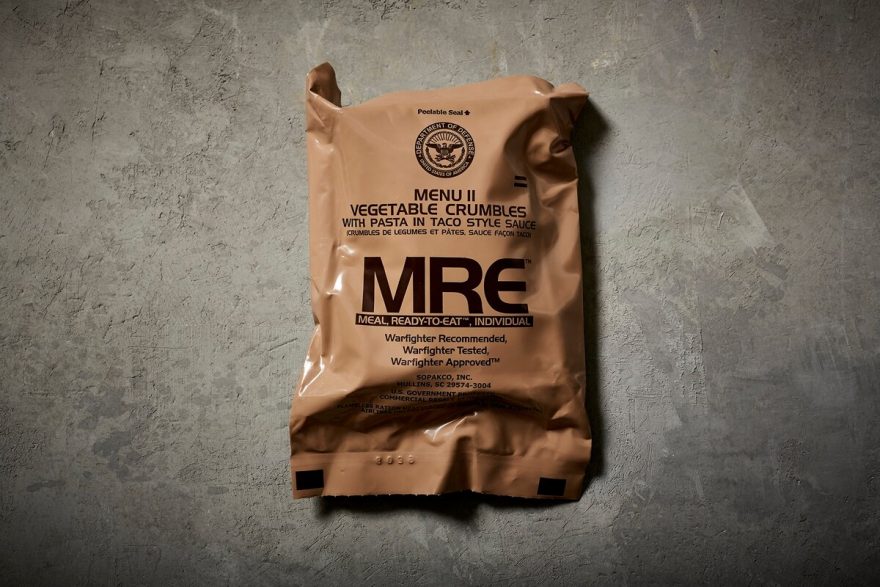MREs have become incredibly popular during the age of Corona. Here we break down some of the biggest reasons why MREs are such a sought-after method for food emergency resolution.
Troops are Quarantined
Purchases of MREs have increased since the outbreak of COVID-19. Increased orders have been conducted to serve troops quarantined in Guam. An additional 4,600 cases were delivered to a naval base in Japan to feed crew members. 7,632 orders were given to troops stationed in Japan. These deliveries were made possible by partners stationed in Japan, Korea, Guam, and Hawaii. Order management and sourcing also took place in Philadelphia. In South Carolina, meal kits were provided for customers restricted to Fort Jackson. Increased consumption of MREs is a direct response to COVID-19 restrictions.
Weather Conditions and Covid
Cities are offering MREs to individuals enduring food insecurity from winter storms. In Austin, Edwin Marty, the region’s food policy manager, stated that 30,000 emergency meals were distributed in 24 hours. Freezers and grocery stores were wiped out by the effects causing people to seek out MREs as grocery alternatives. In addition to winter storms, wildfires were also a significant concern that prompted the increased purchases of MREs. People rely on MREs when attacks are extended to avoid the risk of food unavailability. In conjunction with the coronavirus, wildfires have prompted professionals to rely on MREs for safety.
Contactless Delivery and MRE Canada
In other news, people prefer to purchase MRE Canada in order to avoid potential contamination from coming in contact with the virus. MREs are another alternative to relying on delivery services such as Instacart to receive food without contact. Given the high social distancing requirements that have taken place in major cities across the country, the need to find food that is edible for long periods was essential. Due to restricted shopping options for groceries and other basic goods, families and individuals had to rely on pantry staples and MREs to feed their families when store shelves and delivery wait times made receiving food near to impossible. Since MREs can be purchased by independent vendors, families seeking to avoid delayed wait times on their deliveries are looking beyond Amazon to find other sellers capable of delivering ready-to-go meals sooner. This has prompted many families in the US to seek out MREs Canada. Independent sellers in Canada are often able to assist with delivery faster because the demand is much lower. Individuals have had to think outside the box to get their basic needs met.
Food Bank Resources
MREs are popular because they offer a cheap and convenient way to maintain adequate nutrition with contactless curbside delivery. These meals are long-lasting and prevent individuals concerned with the epidemic from coming into close corners with the virus. The growing demand for food assistance across different parts of the US is in response to COVID-19 and the restrictions surrounding dining out and being in close proximity to others. The raised awareness of food insecurity has prompted community efforts to deliver food, and MREs have been a significant part of this process. Food banks rely on MREs to feed their communities in response to the restrictions and stored shortages that have accumulated due to COVID-19. For instance, Rhode Island’s community food bank has since switched over to prepackaged meals after delivering nearly 14,000 pounds of fresh produce after the food insecurity increased from COVID-19. MREs are a convenient and affordable way to distribute more food throughout a region when supplies of typical foods are low.
Reliable Online Options
In addition to resources like community food banks and Instacart, customers rely heavily on online shopping options to get their groceries delivered. Although the wait time for food is often extensive, people are willing to wait to get food. Amazon has been a figurehead of this process as many people are seeking out MRE options through Amazon. Customers can purchase MREs on Amazon from independent sellers. Many people are gravitating towards MREs out of preference. Other food delivery services like Blue Apron are lagging in terms of sales compared to the MRE industry. Some researchers have suggested that at the rate that MREs are being purchased, they could soon replace traditional frozen meals like Lean Cuisine. The interest in MREs instead of other food alternatives is also in response to the greater need to be prepared.
Growing Survivalist Mentality
On top of the more significant concern across the general public regarding food insecurity, those who are always conscious of survivalist behaviors are even more prone to act accordingly in the case of potential threats. Survivalist-minded individuals add to the consistent purchases of MREs as they prepare their bunkers and various other emergency arrangements with even more commitment than before. As a result of recent winter storms and, of course, the coronavirus, individuals and families are feeling a greater urgency to prepare in the case of emergency. MREs offer a 3 to 5-year shelf life, which makes them a top choice for food preparation in times of crisis. The reality of the pandemic and weather conditions has prompted people to act more deliberately about the threat of food insecurity. The need to prepare has encouraged people to purchase MREs, and this is why they are so successfully sold right now.
Unemployment and Food Insecurity
The unemployment rate has increased since Covid and has caused many families to lose so much money that they cannot feed themselves. To address these needs, community advocates have purchased MREs to provide thousands of families food. For instance, one individual in Miami executed a mass-feeding effort by ordering about 500,000 MREs to feed those without enough food in response to the increased unemployment.
There are plenty of reasons why MREs are so popular right now, but the biggest reason comes down to food insecurity, and the need to prepare in the case of crisis. MREs are an affordable and convenient way to maintain one’s nutrition without the threat of exposure or food insecurity.
